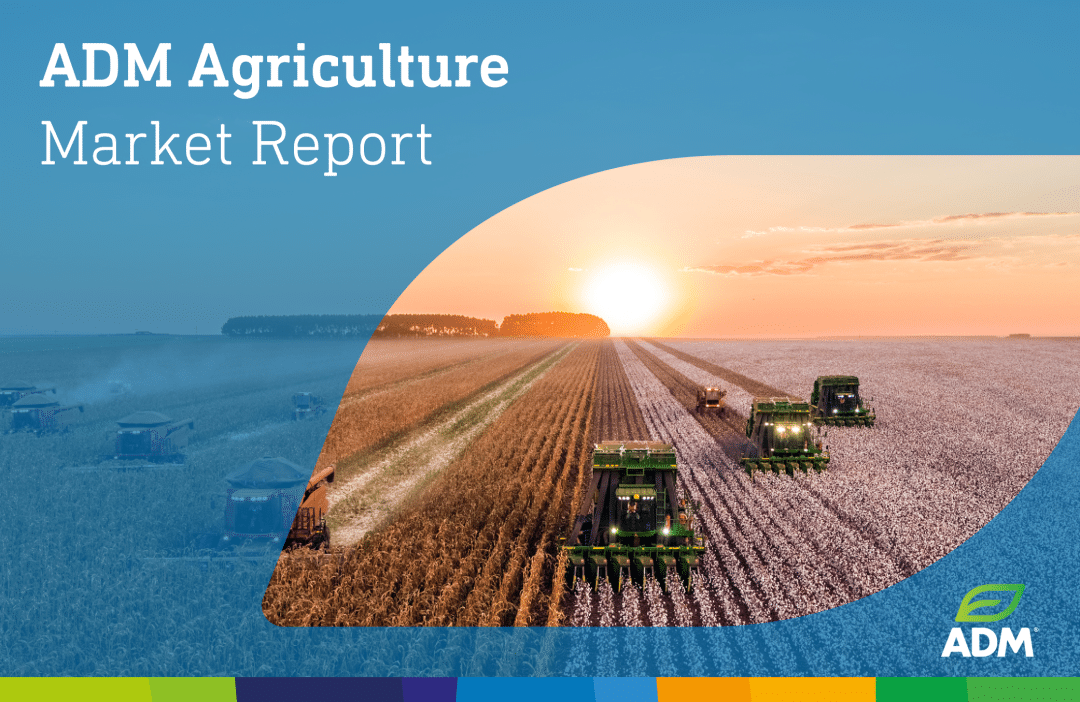WELCOME TO THE ADM AGRICULTURE WEEKLY MARKET REPORT
Wheat
- Even though the US market sentiment seemed firmer, Chicago has traded lower w/w, down 3.25c/bushel or $1.19/t.
- It seems like the market is trying to add weather premiums to prices. Wild weather swings are set to bring colder conditions down into the plains, increasing the risk of a late frost or freeze.
- However, current winter wheat conditions in the southern plains are better than last year, with the trade waiting to see if any damage occurs on the extended cold snap forecast.
- European prices are virtually unchanged on the week, trading down just €0.25/t. Prices are still being driven by offers from the Black Sea, although EU soft wheat exports are now just 3% lower y/y at 20.5mln t.
- MARS, the EU’s crop-monitoring unit, reported that cereal yields in Morocco and Algeria are seen at 15-19% below the five-year average due to drought, which could support EU old crop prices due to greater import requirements.
- The best-performing market has been ICE London wheat futures, with prices up £2.40/t w/w. Farmer selling remains erratic, with many believing prices will appreciate due to reduced supplies during the harvest period. The recent fall to a two-year low in prices has allowed delivery premiums to widen, extending the logistical pull of grain from the surplus areas to the more deficit areas, with no current signs of the premiums narrowing as prices recover.
- In summary, weather will now increasingly play a significant role in pricing, especially within the US. Weak Russian prices remain a restrictive factor for US wheat futures and will limit how far they can rally. However, US fund managers remain heavily short, and if they decide to cut their exposure to weather risks, weak global values and fundamentals will not stand in their way!
Malting Barley
- Old crop malting barley markets continue to drift with the absence of buyers notable for another week. Questions remain over the quality of the EU crop, but it appears buyers are still comfortable about their coverage.
- New crop FOB markets are sharply higher w/w, as continued rains push buyers into the market to take cover, meanwhile, farmer selling is close to zero. Expect sellers to remain cautious and liquidity to stay low, at least until weather conditions improve or farmers start to sell new crop supplies.
- On paper, the market is expecting higher UK/EU production y/y, and if planting conditions improve, we could quickly see last week’s gains given back. All hangs in the balance and whether rainfall persists in the coming weeks.
Feed Barley
- Old crop feed barley prices have moved sideways on the week, as farmer selling has dried up – however, demand is still subdued.
- The export business that was ongoing over recent weeks has stopped, and UK replacement now sits nearly €10 higher than buying interest in Ireland/Spain.
- We continue to see better demand from consumers on new crop, and with continued rains contributing to a lack of farmer selling, the market is starting to build in a weather premium, with the spread vs wheat narrowing by approx £5/mt w/w.
- New crop barley prices are once again uncompetitive for export once again.
Rapeseed
- Soybeans are close to unchanged this week after finding decent support around $11.40, which is the lowest level we have seen since late 2020. On Monday, weekly export sales reflected the lacklustre demand we have seen recently, coming in at the fourth lowest level in more than 30 years. China did reportedly buy twenty cargoes from Brazil last week, but even that was lower than expected after the break for Chinese New Year. US prices are seeing additional pressure from reports that a chicken producer on the East Coast is importing Brazilian beans. A lower close this week would bring the eleventh week in a row that soybeans have been lower – we would need to finish below $11.41’6.
- In South America, we have seen poor yields in Brazil continue to reduce forecasters estimates for crop production as harvest surpasses the 40% mark. In Argentina, volatile temperature swings led to reductions in crop expectations there, although next week increased precipitation is expected to bring needed relief. This week, the Brazilian government released data showing February soybean exports close to 8.3mln t vs 7.3mln t in their earlier forecast.
- Energy markets have been higher this week, as record equity market gains improve global energy demand optimism and the potential for Middle East supply disruptions elevate following further attacks. There has been news of a potential agreement for a ceasefire, however so far nothing has materialised. Data from the EIA report was mixed. Stocks were 4.199 million barrels higher, to sit 33.044 million barrels below last year, and 2.012 million barrels below the five-year average. Crude oil inventory deficit to year-ago levels narrowed. US refinery operating rate rose 0.9% to 81.5%.
- Veg oils have been mixed this week. We have seen some positivity ahead of Ramadan as demand is expected to increase. On the other hand, US biofuel credit hit a three-year low this week and is expected to stay suppressed, as declining feedstock costs are set to stay low due to renewable output rises. This could reduce incentives for fresh investments in biofuel production as the premium continues to drop.
- Canola is higher this week, despite funds adding to their net short, now at a record 153,000 contracts, which is 50% of the short open interest in canola. In the last month, commercial canola stocks have built over 30% and sit at 1.30mln t, representing 80% of the average stockpiles for late February. Farmer selling has continued to pick up but remains 2mln t behind the seasonal average.
- MATIF rapeseed is close to unchanged this week, as prices struggle to see any positivity, with crush margins in the EU favouring soybeans. Crush coverage remains ample for the season, however, there is optimism for prices going into 2025, as new deforestation legislation may lend support.
Oats
- European oat markets have been relatively illiquid over the last week, with limited trades being reported into the EU. Milling oat demand is coming into question given the unaffordable prices buyers are needing to pay in order to secure supply. Feed oat supply is very limited and expensive, and this continues to limit inclusions in feed rations.
- New crop production prospects are starting to become a flagged issue, with further rain preventing plantings. If this continues, it could support prices for the crop 2024 season. Here in the UK, old crop continues to be hard to source, with limited tonnages being sold on farm. Buyers remain interested in covering nearby shorts, however, we could see imports feature at some point, and this will lower demand appetite. Wet weather has continued to frustrate UK farmers, and this is increasing concerns about new crop supplies. Bottom line, markets remain challenging with limited trade being reported.
Pulses
Peas
- The domestic pea market continues with the same story from recent weeks – the ongoing import duty situation in India, lack of open material, and quality of peas are driving price direction on both the human consumption and feed markets. Large blue peas being in such strong demand, both domestically and in Europe, have risen in price to the strongest level we have seen in recent years. Imported values from large exporters are continuing to rise further, pushing UK prices up.
- Please contact your farm buyer should you have any open market parcels available.
- With spring plantings fast approaching, we still have our 2024/25 buybacks available, and they can be planted much later than many other spring crops, should you still be undecided on what is to go on your land! Peas are a nitrogen-fixing crop and provide the best first wheat yield post-growing peas. We offer great movement plans into our Long Sutton facility and have storage availability for the months pre-Christmas 2024, assisting you by getting the peas away from farm before we enter the new year!
Seed
- As we near the end of our final production runs, we now have small tonnages of spring seed available for immediate dispatch.
- We would advise those planning their rotations to cover seed requirements sooner rather than later for autumn drilling. Due to the extreme weather conditions causing issues with autumn 2023 drilling, seed crop area and yields are predicted to be down, therefore we expect seed supply to be limited across all mainstream varieties this coming year.
- Since the rollout of the Sustainable Farming Incentive, applications have continued to rise. At ADM we have a vast portfolio of mixes available plus the option of making them bespoke.
- We also have a good portfolio of maize seed, ranging from 160 FAO to 240 FAO, and suiting different end uses, including grain, forage, and biogas.
- Check out this YouTube video to find out more about our maize varieties, drilling, choosing a variety, and game maize.
Fertiliser
- Granular urea remains relatively stable on North African markets, although some weakness may appear in what remains a quiet spot market.
- Demand is set to return from the US and Europe, and another Indian tender announcement should then support values through into Q2.
- Natural gas prices in both Europe and the US have softened, indicating ammonia prices could fall as we head towards Q3 2024 once spring demand has dissipated. Nitram, UK AN, prices remain flat for April and May deliveries as the application window for fertiliser continues to be made difficult by inclement weather. A few sunken tractors have been seen over the last week in attempts at applying fertiliser.
- TSP levels have weakened, and until ammonia pricing softens further, more TSP from Morrocco could be made available, before some suppliers with the flexibility to swap into DAP production, change production plans from TSP.
- MOP has found a new level on UK farms, which has seen business increase on the 60% K product, whilst DAP pricing remains stable to firm for the foreseeable.
- Liquid UAN prices remain available through ADM for spring delivery. Delivery lead times remain minimal for the UAN and UAN+ATS grades. N18 products remain available for milling wheat crops from ADM also.
| £/€ | £/$ | €/$ |
|---|---|---|
| 1.1680 | 1.2660 | 1.0848 |
| Feed Barley £ | Wheat £ | Beans £ | Oilseed Rape £ | |
|---|---|---|---|---|
| Mar 2024 | 130-145 | 158-173 | 240-250 | 335-340 |
NB: Prices quoted are indicative only at the time of going to press and subject to location and quality.
“Although ADM Agriculture take steps to ensure the validity of all information contained within the ADM Agriculture Market Report, it makes no warranty as to the accuracy or completeness of such information. ADM Agriculture will have no liability or responsibility for the information or any action or failure to act based upon such information.”
ADM Agriculture cannot accept liability arising from errors or omissions in this publication.
ADM Agriculture trade under AIC contracts which incorporate the arbitration clause.
Terms and Conditions of Purchase.
On every occasion, without exception, grain and pulses will be bought by incorporating by reference the terms & conditions of the AIC No.1 Grain and Peas or Beans contract applicable on the date of the transaction. Also, we will always, and without exception, buy oilseed rape and linseed by incorporating by reference the terms & conditions of the respective terms of the FOSFA 26A and the FOSFA 9A contracts applicable on the date of the transaction. It is a condition of all such transactions that the seller is deemed to know, accept and understand the terms and conditions of each of the above contracts.


